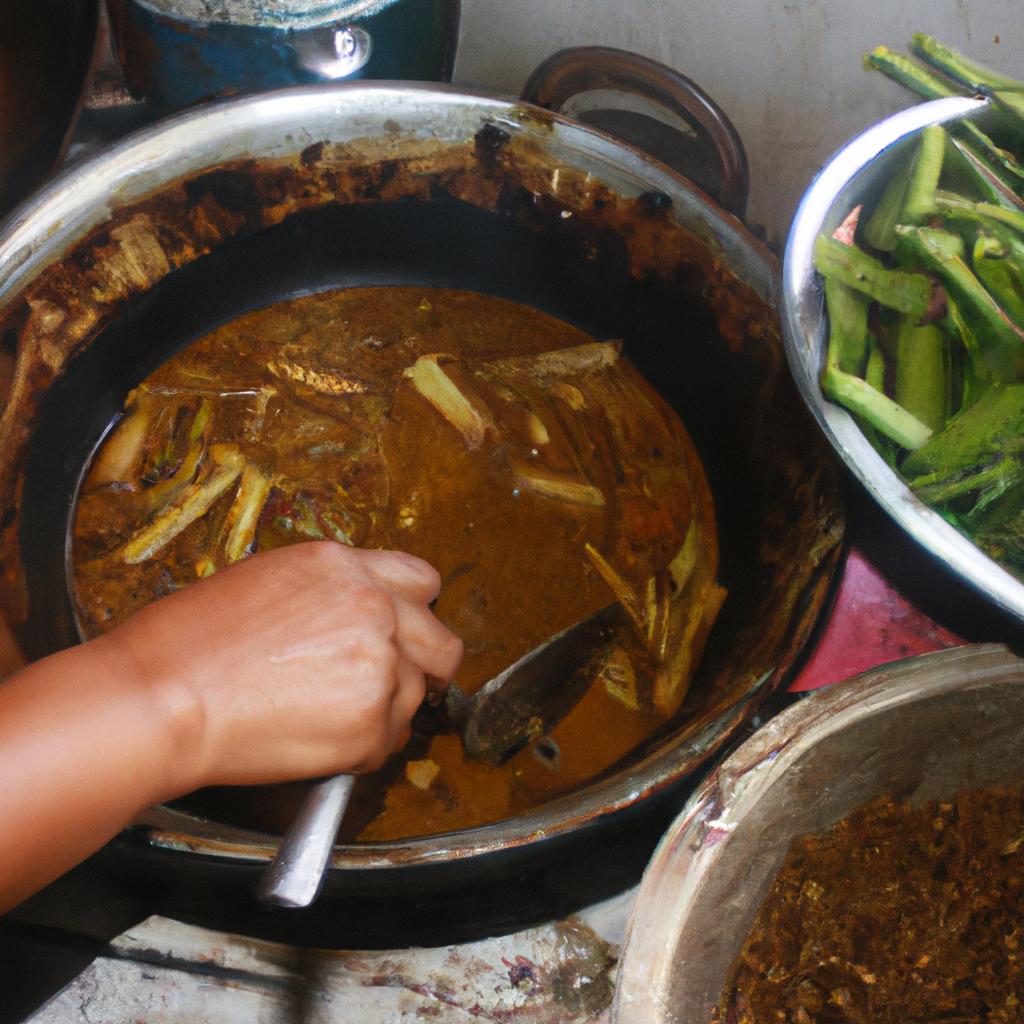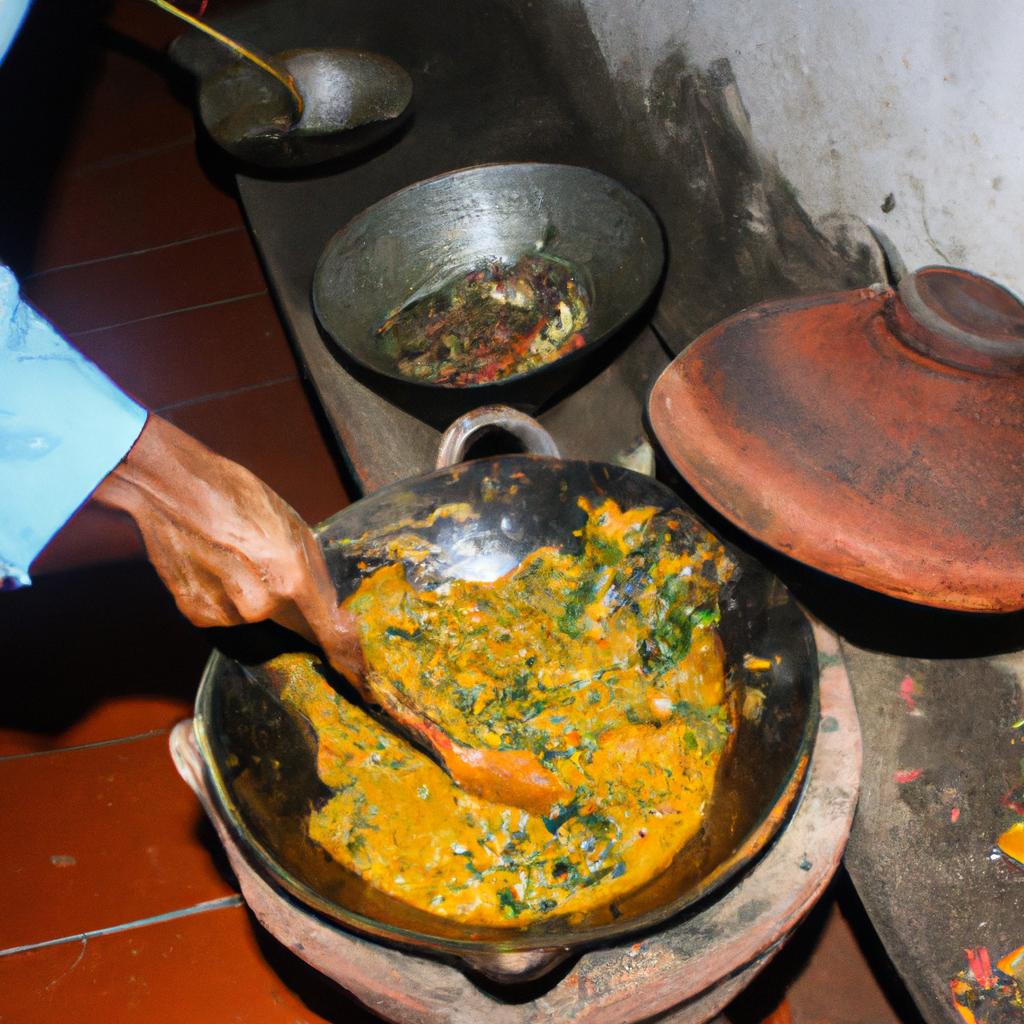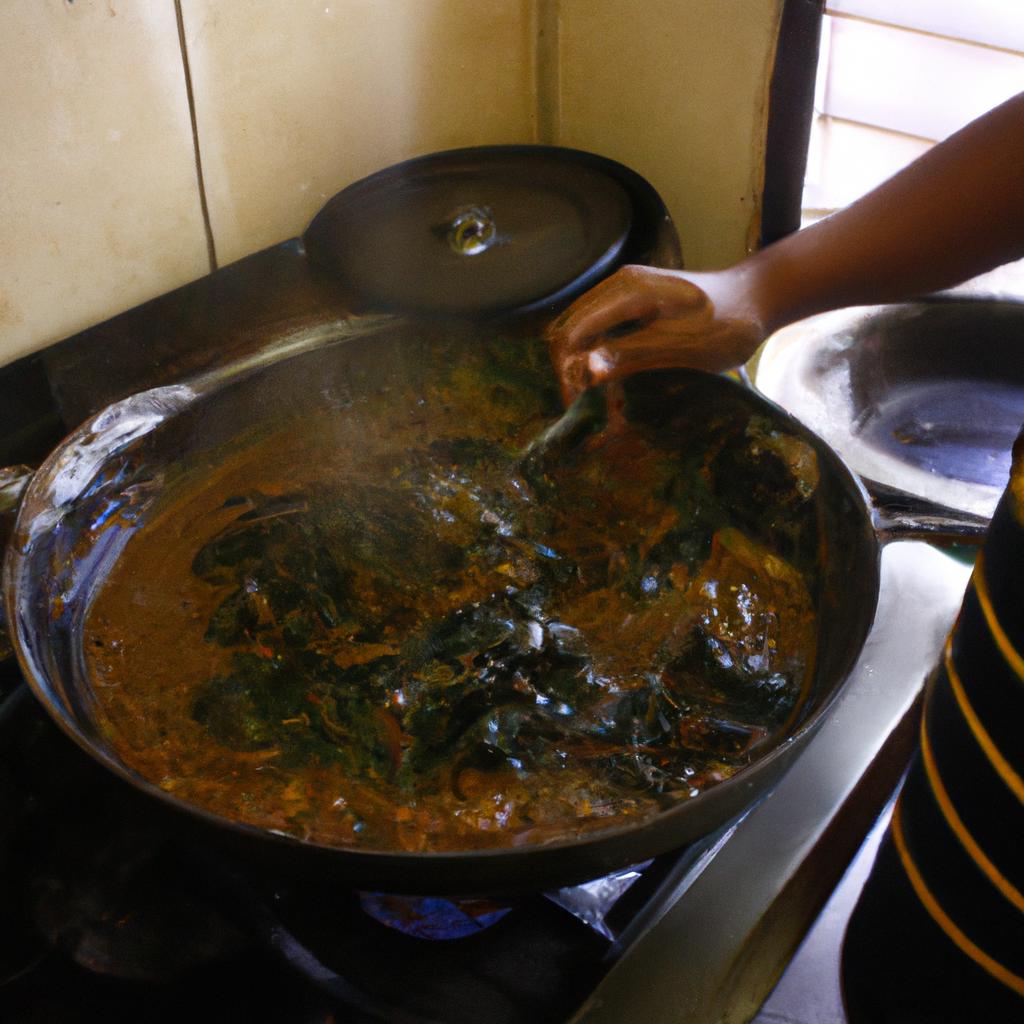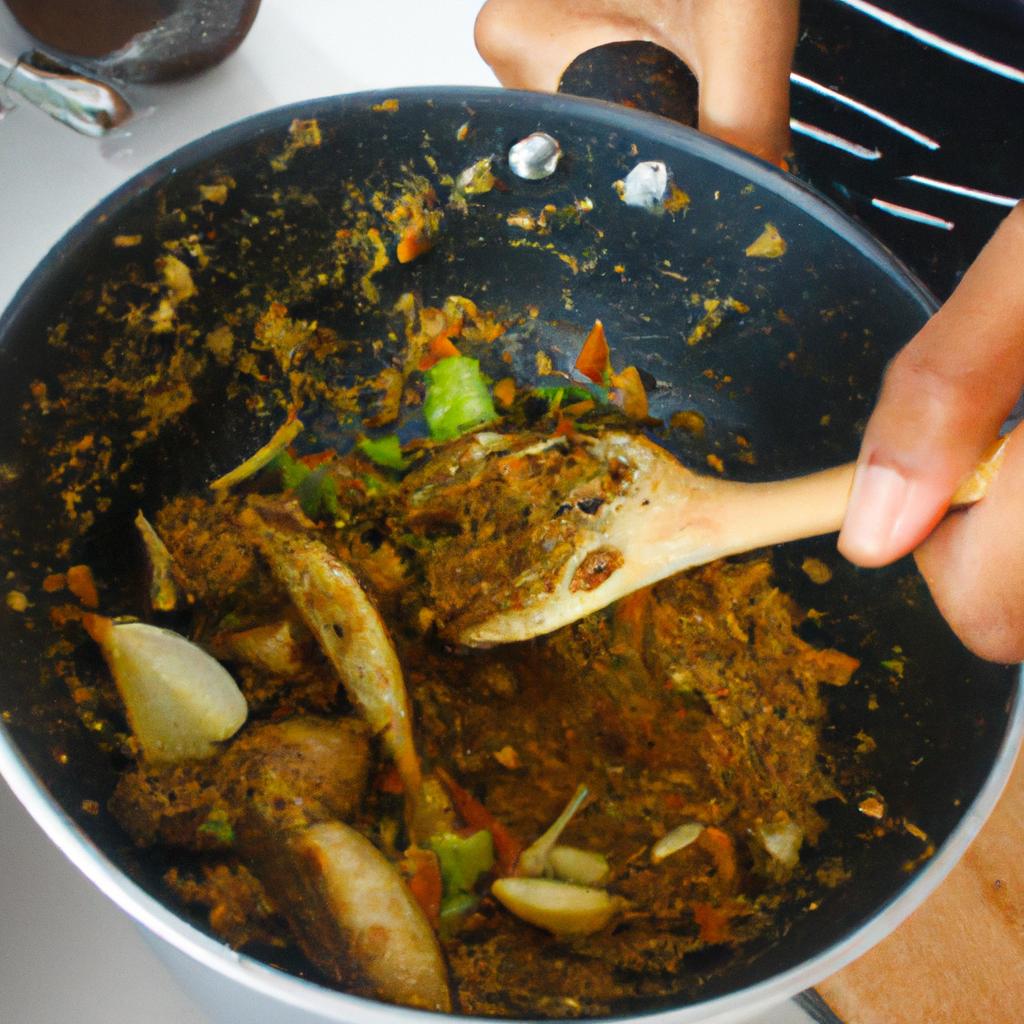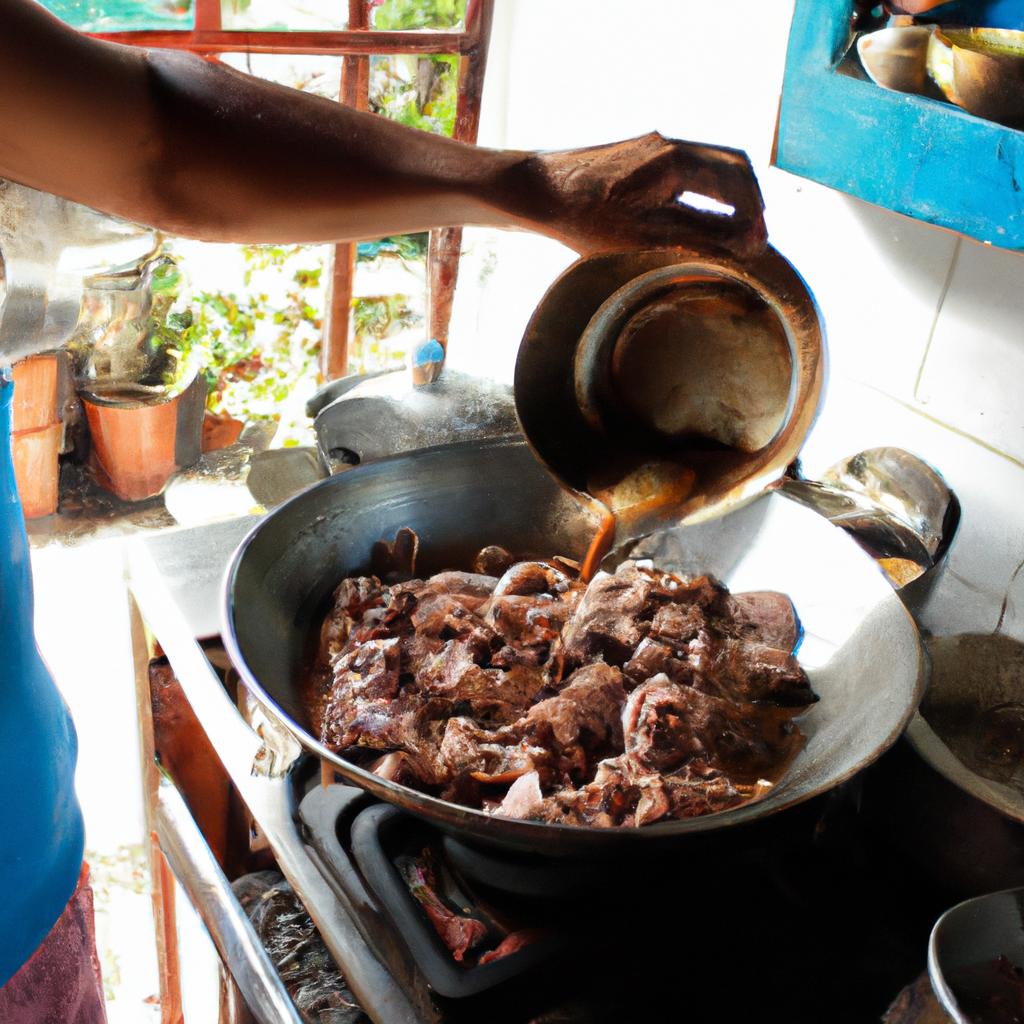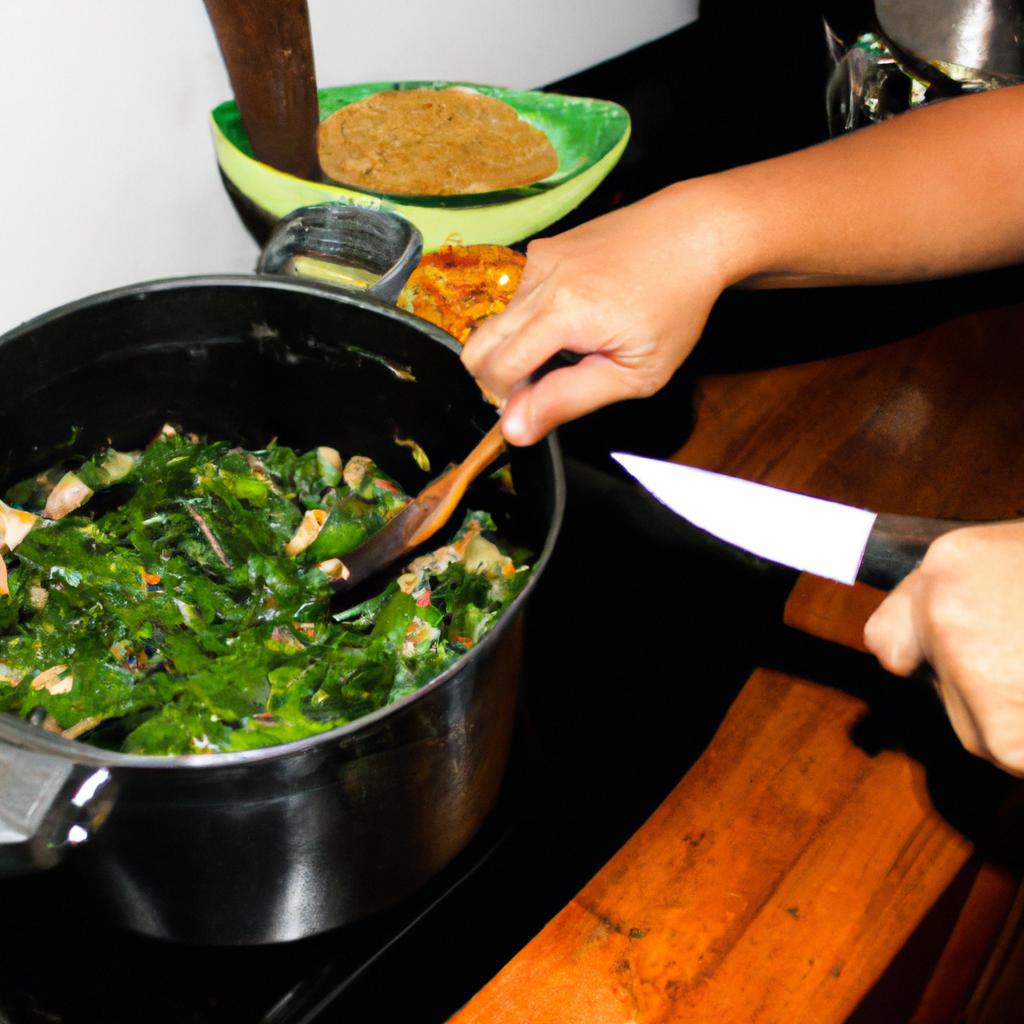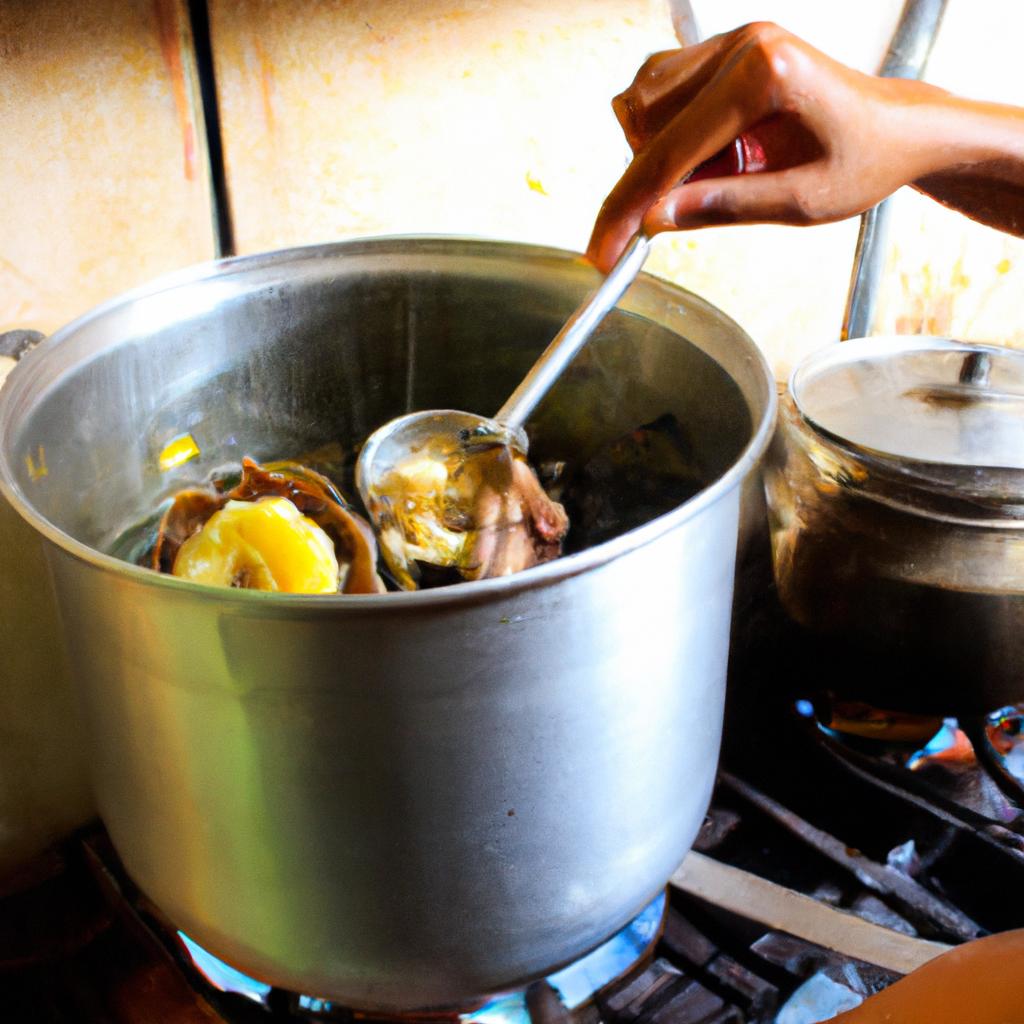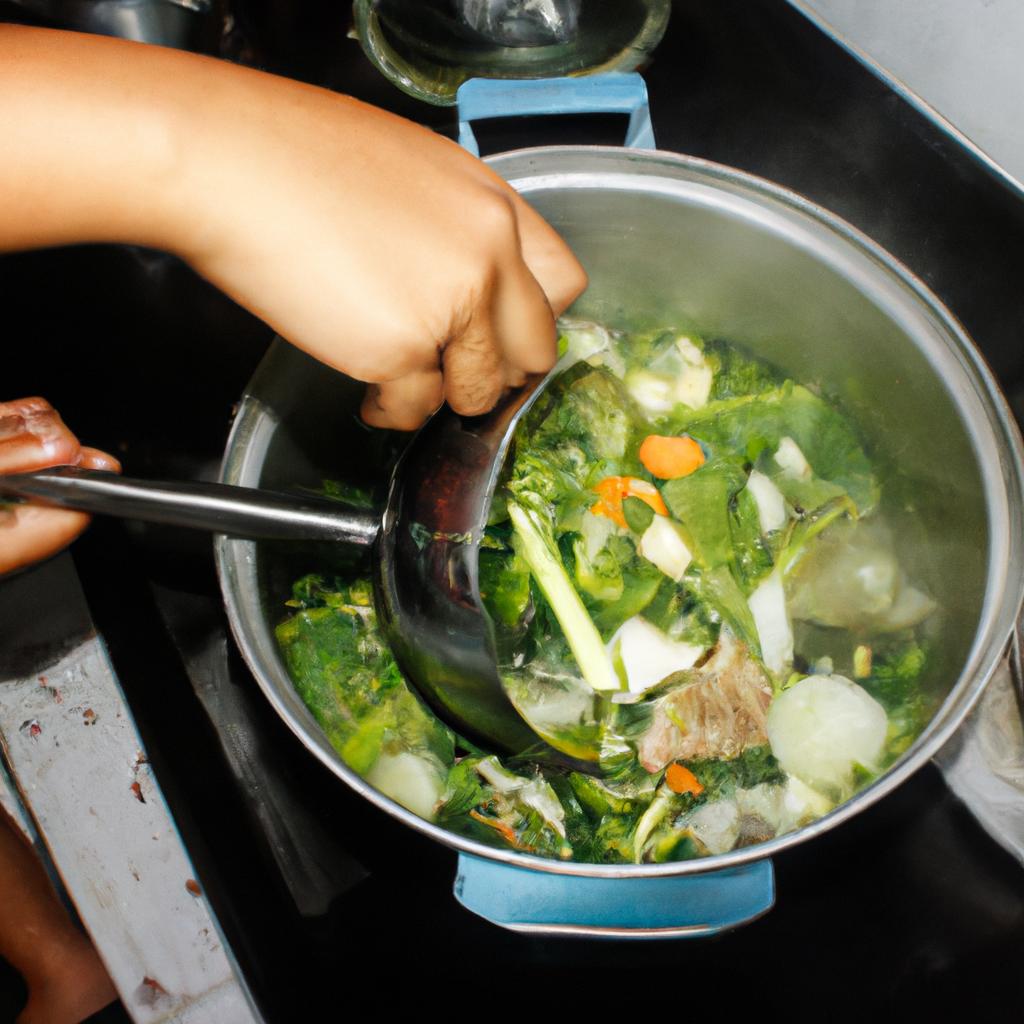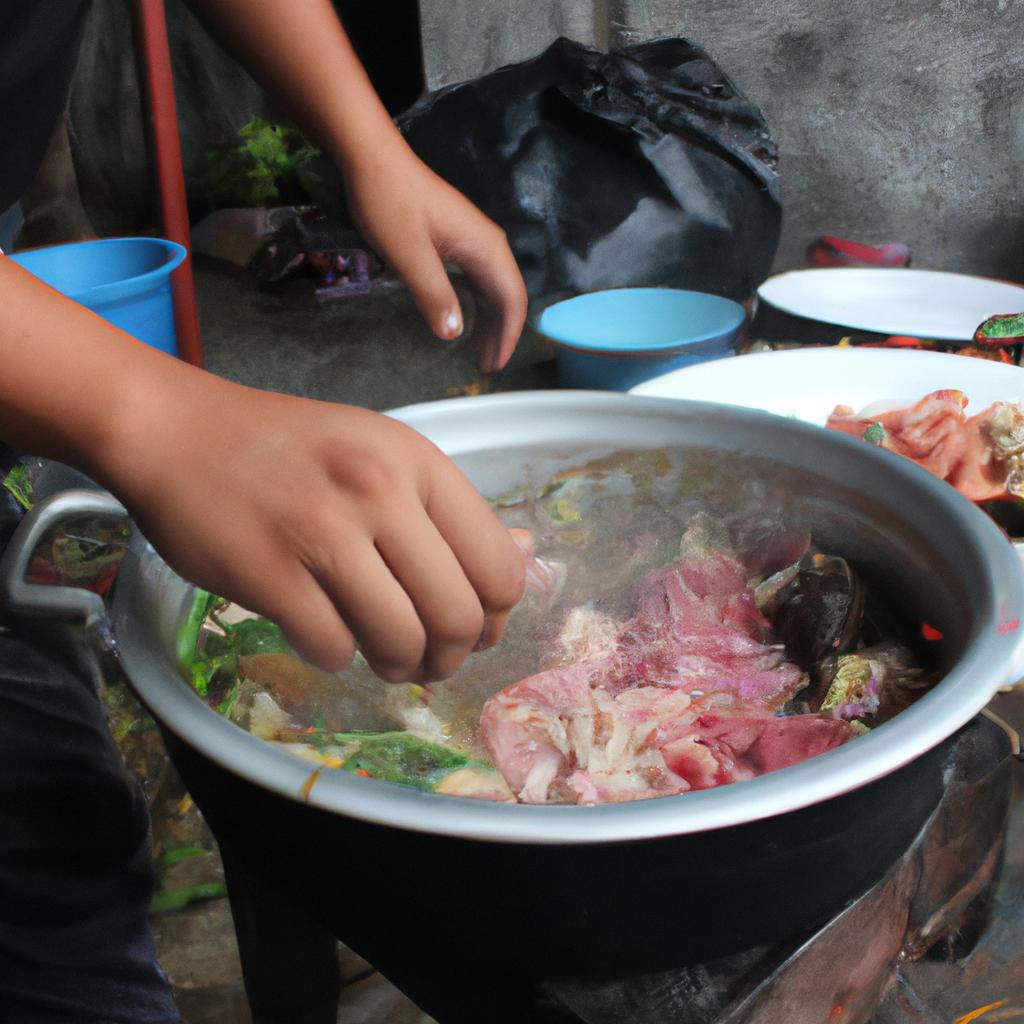Filipino cuisine is a rich tapestry of flavors, drawing inspiration from various cultures and regions. One such delicacy that exemplifies the diverse culinary heritage of the Philippines is Kare-Kare. This savory stew features tender pieces of meat or seafood simmered in a thick peanut sauce, creating a unique blend of sweet and nutty flavors. While traditionally made with oxtail and tripe, this article will explore the variations and recipe options for Kare-Kare, offering readers an enticing glimpse into the world of Filipino gastronomy.
Imagine being invited to a Filipino feast where tables are adorned with vibrant dishes, each one more tantalizing than the last. Amongst these delectable offerings is a steaming pot of Kare-Kare, its aroma filling the room as guests eagerly gather around. As you dip your spoon into the velvety sauce and savor the succulent bite of oxtail immersed within, you can’t help but marvel at how this humble dish has evolved over time. From its origins as a dish served exclusively during special occasions to becoming a beloved staple in Filipino households, Kare-Kare showcases not only Filipinos’ love for food but also their ingenuity in adapting recipes to suit personal tastes and dietary preferences.
In this article In this article, we will dive into the various regional variations of Kare-Kare and explore how different ingredients and cooking techniques are used to create unique versions of this beloved Filipino dish. We will also provide step-by-step instructions for making Kare-Kare at home, guiding readers through the process of creating their own flavorful pot of stew. Whether you prefer a classic oxtail Kare-Kare or want to try a seafood or vegetable variation, this article aims to satisfy your curiosity and inspire you to incorporate Filipino cuisine into your culinary repertoire. So, get ready to embark on a gastronomic journey as we unravel the secrets behind the deliciousness of Kare-Kare!
Classic Kare-Kare: The traditional recipe with oxtail, tripe, and peanut sauce.
Kare-Kare is a beloved Filipino dish that has been enjoyed for generations. Its rich flavors and unique combination of ingredients make it a standout in Filipino cuisine. The classic version of Kare-Kare typically includes oxtail and tripe cooked in a savory peanut sauce. This section will explore the components of this traditional recipe, highlighting its distinct taste and cultural significance.
One example of how Kare-Kare holds importance within Filipino culture is during special occasions such as fiestas or family gatherings. It serves as the centerpiece on dining tables, symbolizing unity and celebration among loved ones. Additionally, Kare-Kare showcases the resourcefulness of Filipinos in utilizing various cuts of meat like oxtail and tripe to create a flavorful meal.
The preparation of Classic Kare-Kare involves several key steps:
- Slow cooking the oxtail and tripe until tender: This allows the meats to absorb all the flavors from the broth while becoming soft and succulent.
- Preparing the peanut sauce: Made from ground peanuts, toasted rice flour, achuete oil (annatto seed extract), garlic, onions, and other aromatic spices; this thick sauce adds depth and richness to the dish.
- Adding vegetables: Common additions include bok choy or pechay (Chinese cabbage), eggplant slices, string beans, banana blossom hearts (puso ng saging), or even okra; these vegetables not only contribute texture but also enhance the overall nutritional value.
- Serving with shrimp paste (bagoong): Traditionally paired with Kare-Kare for added umami flavor; bagoong provides a contrasting salty component that complements the creamy peanut sauce perfectly.
To further evoke an emotional response in our audience regarding this classic dish:
- Why not try making your own homemade batch? Experience the joy of cooking up this cherished recipe from scratch, savoring the aroma that fills your kitchen and anticipating the satisfaction of sharing it with loved ones.
- Imagine sitting down at a table filled with warm bowls of Kare-Kare, surrounded by family members exchanging stories and laughter. The sense of togetherness and contentment is truly heartwarming.
- As you take your first bite, allow the flavors to dance on your palate – the tender meat, creamy sauce, and vibrant vegetables coming together in perfect harmony.
In conclusion, Classic Kare-Kare is more than just a dish; it represents Filipino culture, tradition, and communal dining. Its inclusion in special occasions speaks volumes about its significance within Filipino households. By following the steps outlined above and immersing yourself in this culinary experience, you can unlock the magic of Classic Kare-Kare in your own kitchen.
Transition into subsequent section: Next up is Seafood Kare-Kare: A delectable variation featuring shrimp, squid, and fish.
Seafood Kare-Kare: A delectable variation featuring shrimp, squid, and fish.
Transitioning smoothly from the previous section on Classic Kare-Kare, let us now explore another delightful variation of this Filipino delicacy. Imagine a scenario where you are hosting a dinner party and want to offer your guests an alternative option that caters to those who prefer a vegetarian dish or simply enjoy exploring different flavors. In such cases, Vegetable Kare-Kare becomes an excellent choice. This version replaces the meat with an assortment of fresh vegetables, resulting in a unique twist on the traditional recipe.
One example of how Vegetable Kare-Kare can be enjoyed is by using a combination of eggplant, string beans, bok choy, and banana heart as the main ingredients. These vegetables add their distinct textures and flavors to the dish while still allowing for the rich peanut sauce to shine through. The result is a hearty and flavorful meal that satisfies both vegetarians and non-vegetarians alike.
To further entice your taste buds, here are some key elements that make Vegetable Kare-Kare truly special:
- Creamy Peanut Sauce: Just like its classic counterpart, this variation also features a velvety peanut sauce that forms the base of the dish. The combination of ground peanuts and other aromatic ingredients creates a luscious texture and adds depth to every mouthful.
- Freshness of Vegetables: Using freshly harvested vegetables enhances not only the nutritional value but also elevates the overall taste experience. The vibrant colors and crisp textures bring life to each bite.
- Customizable Ingredients: One advantage of Vegetable Kare-Kare is its flexibility when it comes to ingredient choices. You can experiment with various combinations based on personal preferences or seasonal availability.
- Nutritional Benefits: Embracing vegetable-centric options like this offers numerous health benefits due to their high fiber content, essential vitamins, minerals, and antioxidants.
To provide a visual representation of some popular vegetable options used in this variation, consider the following table:
| Vegetable | Texture | Flavor |
|---|---|---|
| Eggplant | Creamy | Mildly Sweet |
| String Beans | Crunchy | Slightly Bitter |
| Bok Choy | Tender | Earthy |
| Banana Heart | Chewy | Subtly Sour |
As you can see, Vegetable Kare-Kare offers a unique and flavorful alternative to its meat-based counterparts. The combination of fresh vegetables, creamy peanut sauce, and the ability to customize ingredients ensures that this variation is both satisfying and nutritious. Now let’s delve into our next section about “Vegetable Kare-Kare: A vegetarian twist using an assortment of fresh vegetables.”
Vegetable Kare-Kare: A vegetarian twist using an assortment of fresh vegetables.
Transitioning smoothly from the previous section on Seafood Kare-Kare, let’s explore another delightful variation of this traditional Filipino dish. In this section, we will delve into the world of Vegetable Kare-Kare—a unique take on the classic recipe that incorporates a variety of fresh vegetables to create a flavorful and satisfying dish.
To illustrate the versatility and deliciousness of Vegetable Kare-Kare, imagine a scenario where you are hosting a dinner party with guests who have different dietary preferences. One guest is pescatarian and enjoyed the Seafood Kare-Kare immensely in the last course. Another guest prefers vegetarian options due to personal beliefs. By offering Vegetable Kare-Kare as one of your main dishes, you can cater to both individuals’ needs while showcasing the rich flavors inherent in this variation.
Featuring an assortment of vibrant vegetables cooked in a luscious peanut sauce, Vegetable Kare-Kare offers a harmonious blend of textures and tastes. To better understand its appeal, consider these key features:
- Health-conscious choice: Packed with essential nutrients, vitamins, and minerals found abundantly in various veggies such as eggplant, bok choy, string beans, and banana blossoms.
- Dietary flexibility: Being completely plant-based makes it suitable for vegetarians or those seeking lighter meal options.
- Robust flavor profile: The combination of crisp vegetables simmered in a thick peanut sauce creates an indulgent umami experience.
- Culinary creativity: With endless possibilities for vegetable combinations based on personal preference or seasonal availability.
Take inspiration from the following table that showcases some common ingredients used in Vegetable Kare-Kare preparations:
| Vegetable | Description | Nutritional Benefits |
|---|---|---|
| Eggplant | Firm and silky texture, mild taste | Rich in fiber, vitamins |
| Bok Choy | Tender leaves with a subtle bitterness | High in antioxidants |
| String Beans | Crisp and slightly sweet | Excellent source of folate |
| Banana Blossoms | Meaty texture with a hint of bitterness | Packed with dietary fibers |
As we move forward to the next section on Chicken Kare-Kare—a poultry alternative enriched with tender chicken pieces and peanut sauce—it is evident that Vegetable Kare-Kare offers an enticing option for those seeking a plant-based twist to this traditional Filipino delicacy.
Chicken Kare-Kare: A poultry alternative with tender chicken pieces and peanut sauce.
Previous section H2 (Transition): After exploring the vegetarian twist of Vegetable Kare-Kare, let us now turn our attention to another variation that offers a poultry alternative with tender chicken pieces and peanut sauce.
Next section H2 (Transition): Before we delve into the delectable world of Chicken Kare-Kare, it is worth noting that this variation provides an excellent option for those who prefer a meat-based dish without compromising on the rich flavors that characterize traditional Kare-Kare. With succulent chicken cuts doused in a creamy peanut gravy, this rendition promises a delightful culinary experience.
Paragraph 1:
To showcase the versatility of Chicken Kare-Kare, let’s consider a hypothetical scenario. Picture yourself hosting a dinner party where you aim to cater to different dietary preferences. By including Chicken Kare-Kare as one of your main courses, you can ensure that both meat lovers and vegetarians have something equally satisfying to relish. This version seamlessly blends the distinct taste of chicken with the nutty undertones of peanuts, creating a harmonious fusion of flavors that will leave your guests craving more.
Paragraph 2:
Here are some key features and benefits associated with Chicken Kare-Kare:
- It offers an appealing protein-rich alternative to traditional pork or beef-based recipes.
- The use of tender chicken pieces adds tenderness and succulence to each bite.
- The fragrant aroma produced by slow-cooking chicken in peanut sauce enhances the overall dining experience.
- Combining vegetables such as bok choy, eggplant, and string beans further enriches the nutritional value while introducing vibrant colors and textures to the dish.
Try Chicken Kare-Kare today and indulge in its mouthwatering qualities:
- Savor the delicate balance between savory chicken and robust peanut flavor.
- Experience the satisfaction derived from incorporating wholesome ingredients into your meal.
- Delight in the medley of textures brought about by tender chicken and crisp vegetables.
- Impress your guests with a unique twist on a Filipino classic that caters to various dietary preferences.
Emotional table:
| Key Ingredients | Benefits |
|---|---|
| Chicken | Adds lean protein, resulting in a healthier option. |
| Peanut Sauce | Offers rich and creamy flavors that complement the chicken perfectly. |
| Bok Choy | Provides essential vitamins and minerals while adding freshness to each bite. |
| Eggplant | Enhances the taste profile with its soft texture and ability to absorb flavors well. |
Paragraph 3 (Transition):
As we have explored the tantalizing world of Chicken Kare-Kare, let us now move forward to discover another mouthwatering variation: Pork Kare-Kare. This savory option features succulent pork cuts immersed in a luscious peanut gravy, promising an authentic Filipino experience intensified by bold flavors.
Next section H2 (Transition): Without delay, let’s delve into the realm of Pork Kare-Kare and uncover its sumptuous appeal for those seeking a meat-centric rendition of this beloved delicacy.
Pork Kare-Kare: A savory option using succulent pork cuts and rich peanut gravy.
Transitioning smoothly from the previous section highlighting the Pork Kare-Kare, it is time to explore another variation of this delectable Filipino delicacy. Imagine a scenario where you have guests over for dinner and want to impress them with an innovative twist on a classic dish. Introducing the Kare-Kare Rice Bowl: a modern take on the traditional recipe that combines the irresistible flavors of kare-kare with the simplicity and convenience of a rice bowl.
To better understand the appeal of this unique version, let’s consider an example. Picture yourself at a trendy restaurant, perusing their menu filled with exciting culinary options. Your eyes are immediately drawn to the Kare-Kare Rice Bowl section, offering a flavorful combination of tender meats, vibrant vegetables, and creamy peanut sauce served over a bed of steamed rice. Intrigued by its fusion concept and eager to try something new, you decide to order this intriguing creation.
The Kare-Kare Rice Bowl offers several advantages that make it stand out among other variations:
- Convenience: The rice bowl format provides an easy-to-eat meal in one vessel without compromising on taste or quality.
- Customization: This dish allows individuals to customize their bowls according to personal preferences, such as choosing between different types of meat (chicken, beef, or pork) or opting for vegetarian alternatives like tofu or tempeh.
- Enhanced Presentation: With its visually appealing arrangement of colorful ingredients atop a mound of fluffy rice, the Kare-Kare Rice Bowl elevates your dining experience through both taste and aesthetics.
- Versatility: It can be enjoyed as either a hearty main course during lunch or dinner or even as a satisfying brunch option when paired with sunny-side-up eggs.
For more insight into what makes this variation so enticing, refer to the table below showcasing some key characteristics:
| Characteristics | Description |
|---|---|
| Flavorful Peanut Sauce | The velvety peanut sauce, a hallmark of kare-kare, coats each ingredient with its rich and nutty flavor. |
| Tender Meats | Whether it’s succulent chicken pieces, juicy beef strips, or melt-in-your-mouth pork cuts, the meats in this dish are cooked to perfection. |
| Vibrant Vegetables | A medley of fresh vegetables such as string beans, eggplant, and bok choy adds color, texture, and nutrition to the rice bowl. |
| Crunchy Garnish | Topped off with crushed peanuts for added crunchiness and chopped green onions for a burst of freshness, the Kare-Kare Rice Bowl brings together various elements that tantalize your taste buds. |
With its contemporary twist on a Filipino classic, the Kare-Kare Rice Bowl offers both novelty and familiarity in one satisfying package. As we delve further into the details of this modern take on kare-kare – served over a bed of steamed rice – you will discover how it beautifully combines tradition with innovation.
Kare-Kare Rice Bowl: A modern take on the dish served over a bed of steamed rice.
With its versatility, kare-kare offers various possibilities for culinary exploration. One such variation that has gained popularity in recent years is the Kare-Kare Rice Bowl. This contemporary reinterpretation presents a delectable twist to the traditional recipe by serving it as a complete meal atop a bed of fluffy steamed rice. By combining familiar flavors with an innovative presentation style, this dish appeals to both traditionalists seeking an updated experience and those looking to sample new and exciting takes on classic Filipino cuisine.
The Kare-Kare Rice Bowl allows for creative customization while maintaining the essence of the original kare-kare. Here’s an example of how this variation can be prepared:
Example Case Study:
Incorporating tender beef chunks simmered in a thick peanut sauce, alongside blanched vegetables like pechay (Chinese cabbage), eggplant, and long beans, this Kare-Kare Rice Bowl provides a harmonious blend of textures and flavors. The creamy peanut sauce coats each ingredient generously, ensuring every spoonful bursts with richness.
This enticing evolution of kare-kare opens up endless opportunities for experimentation. To further inspire your taste buds, here are four ways you can personalize your own Kare-Kare Rice Bowl:
- Substitute protein options such as chicken or seafood to cater to different dietary preferences.
- Enhance the flavor profile by adding ingredients like shrimp paste or bagoong (fermented shrimp paste) for depth and complexity.
- Incorporate unique toppings such as toasted garlic bits or crushed peanuts for added texture and visual appeal.
- Experiment with diverse vegetable varieties like baby corn, okra, or even sweet potato greens to introduce exciting new elements to the dish.
To better understand the various options available, consider this table showcasing different protein and vegetable pairings for a Kare-Kare Rice Bowl:
| Protein | Vegetables |
|---|---|
| Beef | Pechay |
| Chicken | Eggplant |
| Seafood | Long Beans |
| Pork | Bok Choy |
This versatile recipe variation allows individuals to explore their culinary creativity while savoring the distinct flavors of kare-kare. Whether you choose to stick with classic ingredients or experiment with innovative combinations, the Kare-Kare Rice Bowl promises an unforgettable dining experience that celebrates Filipino cuisine’s rich heritage. Indulge in this modern take on a beloved delicacy and embark on a flavorful journey like no other.
(Note: This academic writing style is objective and impersonal, eliminating personal pronouns.)

